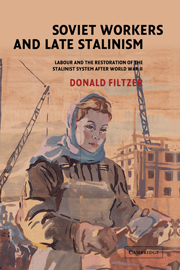 Soviet Workers and Late Stalinism
Soviet Workers and Late Stalinism Book contents
- Frontmatter
- Contents
- List of tables
- Preface and acknowledgements
- List of terms and abbreviations
- Introduction: the political imperatives of the postwar recovery
- 1 Rebuilding the workforce: free, slave, and indentured labour
- 2 The food crisis of 1946–1947
- 3 Attenuated recovery: the end of rationing, housing, and health
- 4 ‘Socializing’ the next generation: the position of young workers
- 5 Labour discipline and criminal law: the futility of repression
- 6 The industrial enterprise: working conditions, work organization, and wage determination
- Conclusion: labour and the ‘renormalization’ of Stalinist social relations
- Bibliography
- Index
6 - The industrial enterprise: working conditions, work organization, and wage determination
Published online by Cambridge University Press: 07 August 2009
- Frontmatter
- Contents
- List of tables
- Preface and acknowledgements
- List of terms and abbreviations
- Introduction: the political imperatives of the postwar recovery
- 1 Rebuilding the workforce: free, slave, and indentured labour
- 2 The food crisis of 1946–1947
- 3 Attenuated recovery: the end of rationing, housing, and health
- 4 ‘Socializing’ the next generation: the position of young workers
- 5 Labour discipline and criminal law: the futility of repression
- 6 The industrial enterprise: working conditions, work organization, and wage determination
- Conclusion: labour and the ‘renormalization’ of Stalinist social relations
- Bibliography
- Index
Summary
The discussion in previous chapters has centred on how events and policies affected the well-being of workers and their families: where they came from, their standard of living, housing conditions, generational problems, and their legal standing. All of these had a profound impact on the way workers internalized their experiences and developed their basic attitudes towards work, the larger society, and the regime. What of their experiences at work itself? For eight hours a day, six days a week (or sometimes even longer), they went out to the factory, construction site, or railyard. It was here that they earned the money required to live; it was here, in production, that they most directly interacted with the regime; and it was here that they fulfilled their role as labour power in the generation of the surplus product and the ongoing perpetuation of the Stalinist system – what in Marx's terminology we would term the system's reproduction.
We know from other periods of Soviet history that what happened inside the industrial enterprise was of fundamental significance to the functioning and development of the system. The Soviet enterprise, as elaborated more fully in this chapter, displayed characteristic features of work organization which were specific to the Soviet system and had long-term consequences for its historical viability. Its patterns and rhythms of production were quite different from those observed in industrialized capitalist countries.
- Type
- Chapter
- Information
- Soviet Workers and Late StalinismLabour and the Restoration of the Stalinist System after World War II, pp. 201 - 244Publisher: Cambridge University PressPrint publication year: 2002


